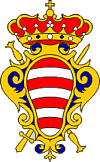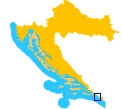|
||||
|
County
|
Dubrovnik-Neretva | |||
|---|---|---|---|---|
|
Area
|
14 335 km | |||
|
Location
|
42.39N 18.04E | |||
|
Population
|
43,800 | |||
Dubrovnik ( Latin: Ragusa) is an old city on the Adriatic Sea coast in the extreme south of Croatia, positioned at 42.39N 18.04E at the terminal end of the Isthmus of Dubrovnik. It is one of the most prominent tourist resorts, a seaport and the center of the Dubrovnik-Neretva county. Its population was 43,770 in 2001, 49,728 in 1991, and the majority of its citizens are Croats with 88.39% (2001 census). Dubrovnik is nicknamed "Pearl of the Adriatic".
The city of Ragusa/Dubrovnik was based on maritime trade; in the Middle Ages, it became the only eastern Adriatic city-state to rival Venice. Supported by its wealth and skilled diplomacy, the city achieved a remarkable level of development during the 15th and 16th centuries. Dubrovnik was one of the centers of the development of the Croatian language and literature, home to many notable poets, playwrights, painters, mathematicians, physicists and other scholars.
HISTORY
Dubrovnik was founded by joining two small towns: Laus, a town on a small island off the southern Dalmatian coast, which provided shelter for the Italic refugees from the nearby city of Epidaurum (today Cavtat); and Dubrava, a settlement of Slavic immigrants at the foot of the forested Srđ hill.
The strip of wetland between the two parts of the town, was reclaimed in the 12th century, unifying the city around the newly-made plaza (today Placa or Stradun). The plaza was paved in 1468 and reconstructed after the earthquake of 1667. The city was fortified and two harbours were built on each side of the isthmus.
From its establishment in the 7th century, the town was under the protection of the Byzantine Empire. After the Crusades, Ragusa/Dubrovnik came under the sovereignty of Venice (1205–1358), and by the Peace Treaty of Zadar in 1358 it became part of the Hungarian-Croatian Kingdom.
Between the 14th century and 1808 Dubrovnik ruled itself as a free state named Respublica Ragusina (Ragusan republic), also known as Republic of Dubrovnik. The Ragusan Republic reached its peak in the 15th and 16th centuries, when the Dubrovnik thalassocracy rivalled the Venetian Republic and other Italian maritime republics.
The city was ruled by aristocracy that formed two city Councils. They maintained a strict system of social classes, but they also abolished slave trade early in the 15th century and valued liberty highly. The city successfully balanced its sovereignty between the interests of Venice and the Ottoman Empire for centuries.
The Republic gradually declined after a crisis of Mediterranean shipping - and especially a catastrophic earthquake in 1667. In 1699 it was forced to sell two patches of its territory to the Ottomans in order to protect itself from the advancing Venetian forces.
Its final demise was caused not by Venice, but by Napoleon's forces, which conquered first the Venetian territories and then the Dubrovnik Republic in 1806. In 1808, Marshal Marmont abolished the republic and amalgamated its territory into the Illyrian provinces.
In 1815, by the resolution of Congress of Vienna, Dubrovnik was annexed to Austria (from 1867 Austria-Hungary), and remained in the Kingdom of Dalmatia until 1918. During that time its official name was Ragusa. It then became part of the Kingdom of Serbs, Croats and Slovenes (Yugoslavia from 1929). At the very beginning of the World War II, Dubrovnik was first part of the Independent State of Croatia. From April 1941 until September 1943, Dubrovnik was occupied by the Italian army and after that by the Germans. In October 1944, the Partisans liberated Dubrovnik from the Germans and it became part of the second Yugoslavia in 1945.
Despite the demilitarization of the old town by the Yugoslav People's Army in the 1970s, in an attempt to prevent it from becoming a casualty of war following Croatia's independence in 1991, the same army attacked and surrounded the city on October 1, 1991 and the siege lasted until May 1992. The heaviest artillery attack happened on December 6 with 19 people killed and 60 wounded. Total casualty in the conflict on this area according to the Croatian Red Cross were 114 killed civilians, among them the celebrated poet Milan Milisič (born 1941).
Following the end of the war, a major rebuilding project led by the Croatian authorities and UNESCO began. They rebuilt the city in the ancient style to keep its sense of beauty and history. As well as rebuilding damaged buildings, surviving structures were strengthened against earthquakes. As of 2005, most damaged buildings in the city have been repaired.
MISCELLANEOUS
The patron saint of the city is Sveti Vlaho (Saint Blaise), whose statues are seen around the city. He has an importance similar to that of St. Mark the Evangelist to Venice.
The old city is a World Heritage Site.
Inhabitants of Dubrovnik often proudly quote the Irish playwright and man of letters, George Bernard Shaw, who visited the city in 1929: "If you want to see heaven on earth, come to Dubrovnik."
Dubrovnik hosted the tenth and final Congrès Internationaux d'Architecture Moderne in 1956.
The oldest arboretum in the world, Arboretum Trsteno, dating from before 1492, is near Dubrovnik.
The Republic of Dubrovnik was the first state to recognise the United States of America as a sovereign state.
The English word argosy is derived from ragusye, which means vessel of Ragusa, the old name of Dubrovnik.
The Australian rock band The Dubrovniks (1987–95) owed its name to the origin of the father of one of the members.
In the bay of Dubrovnik is the 72-hectare wooded island of Lokrum, where according to legend, Richard the Lionheart was cast ashore after being shipwrecked in 1192. The island includes a fortress, botanical garden, monastery and naturist beach.

